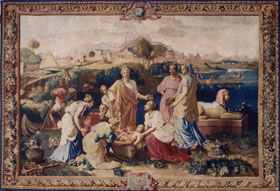Moses saved from the waters

Moïse trouvé sur les eaux
collection du Mobilier national
© Pb.Sébert
Here you can see, side by side, the painting by Nicolas Poussin loaned by the Louvre, dating from 1647; and the tapestry after this work, woven around 1683 by the workshop of Jean Jans (pronounce YANS in the Dutch way) the Younger at the Gobelins tapestry works.
This episode from the Bible comes from the second book of the Old Testament, Exodus. It narrates the circumstances of the birth and the rescue of the infant Moses, the beginning of his extraordinary story...
Pharaoh, threatened by a prediction, orders the killing of all newborn males of the Hebrew people. To save her son, the mother of Moses places the child in a basket and leaves it in the reeds on the banks of the Nile. This is the episode of Moses exposed on the waters. Pharaoh’s daughter, who comes down to bathe in the waters of the Nile, finds Moses in the basket and decides to rescue and bring up this providential child. This is how Moses comes to be saved from the waters.
You will notice that the composition of the painting has been transcribed fairly faithfully to the tapestry. In the middle, a group of women bustle around the infant taken from his basket. Standing among them is the daughter of the Pharaoh, in suitable drapery and crown. The peaceful waters of the Nile stretch away to the right of the picture, on which men in a boat are hunting a hippopotamus. On the horizon, the silhouette of an Egyptian town, with is palm trees, obelisks and pyramids, stands out against the sky.
The tapestry is a faithful reproduction of the painting, give or take a few details. In the painting, at the bottom on the right, the naked male figure leaning on a jar in front of a statue of the Sphinx, is an allegory of the river. In the tapestry he has disappeared completely to make way for the Sphinx represented in its entirety, and a basket of flowers. This is the most visible adaptation of the painting in its tapestry version.
Apart from these changes, the main issue that arises in the transposition of the works of Poussin into tapestry comes from enlarging the paintings, which are in medium-sized formats. Painter-cartoon makers were responsible for transposing them onto "cartoons", of the same dimensions as the future tapestries, to be used as patterns for the weaving process.
To take the comparison further, you can now listen to some selected extracts from the catalogue.
